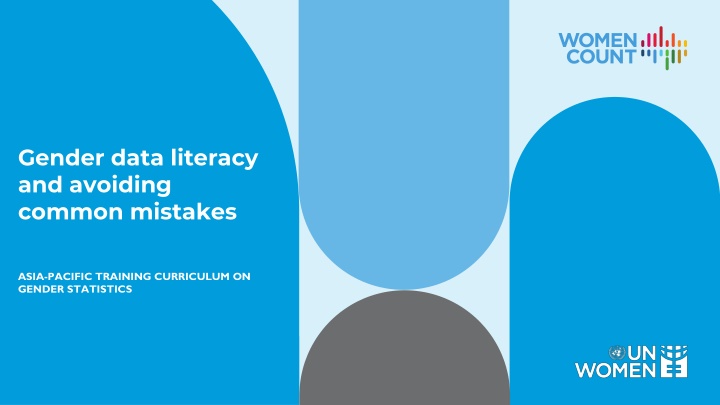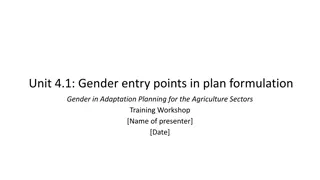
Gender Data Literacy and Avoiding Common Mistakes in Statistics
Enhance your knowledge of gender statistics by learning about data literacy, common mistakes to avoid, official vs. non-official statistics, and the importance of metadata. Gain insights into key concepts and definitions in this area to improve your understanding of gender data.
Download Presentation

Please find below an Image/Link to download the presentation.
The content on the website is provided AS IS for your information and personal use only. It may not be sold, licensed, or shared on other websites without obtaining consent from the author. If you encounter any issues during the download, it is possible that the publisher has removed the file from their server.
You are allowed to download the files provided on this website for personal or commercial use, subject to the condition that they are used lawfully. All files are the property of their respective owners.
The content on the website is provided AS IS for your information and personal use only. It may not be sold, licensed, or shared on other websites without obtaining consent from the author.
E N D
Presentation Transcript
Gender data literacy and avoiding common mistakes ASIA-PACIFIC TRAINING CURRICULUM ON GENDER STATISTICS
- Become familiar with basic data concepts and ensure that the correct meaning, or semantics, of statistics are understood. - Gain knowledge on specific issues of gender data such as time use, violence and crime data, etc. 1 Learning Objectives - Understand the issue of misinterpretation of data and how to avoid it.
Understanding definitions and key concepts in the area of gender statistics 2
Official vs. Non-Official Statistics Official Statistics Non-Official Statistics - Produced by either the National Statistics Office or another government body in charge of data production (e.g. line ministries, National Meteorology Agency, etc.) - Produced by third-party organizations without the involvement of national statisticians - Often narrower in coverage (especially regarding sample sizes) - Produced in accordance with the National Statistics Law/Act and in line with the Fundamental Principles of Official Statistics - Usually ad-hoc studies and one-off data collection experiments - Produced by a third-party organization but cleared by the National Statistical Authority (e.g. National Statistical Office, Statistical Capacity-Building Trust) - Some examples: Figures derived from Census data, official surveys, administrative records
Official vs. Non-Official Statistics What else should I know about official statistics? Official statistics include: Are these official statistics? - Figures derived from Census data - Unemployment rate for January 2019, by sex - Estimates derived from surveys - Proportion of patients whose symptoms improved faster than the placebo group in a clinical trial - Aggregates calculated using administrative records (e.g. birth registration) - In some countries, the government might derive official statistics from non-conventional sources (e.g. big data, crowdsourcing, etc.)
Metadata - Metadata is the information about data - It refers to a range of information, such as: o Context in which statistical information was collected, processed and analyzed o Information about methods o Key concepts o Nomenclatures o Sample and coverage - 2 types of metadata are: o Indicator metadata o Data point metadata
Indicator metadata: What is it and where to find it? - What does it include? - Where to find it? o Official indicator name o Definitions o Rationale o Methods of computation / Formulas o Information about exceptions, methodological concerns and limitations o Information about usual data sources utilized to derive the indicator o If the metadata refers to an SDG indicator, it often also includes information about custodian agencies and methodology for the production of regional aggregates. o On-line repositories (e.g. https://unstats.un.org/sdgs/metadata/) o Example: Metadata for Indicator 5.4.1
Data point metadata: What is it and where to find it? What does it include? Where to find it? o Information about specific datapoints o Explanation about exceptions o Information about coverage o Methodological limitations o Specific details about one particular data point o In the form of footnotes o Alongside data tables or in data cells o In survey reports o Example: data point metadata for the proportion of people living in extreme poverty, disaggregated by sex and age, for the years 2009-2013
Why is metadata important? - Metadata makes data meaningful Do you know what this data is about? o Without metadata, you would not understand data.
Why is metadata important? - Metadata improves comparability of data o Concepts can have different definitions, units and classifications. o To avoid discrepancies and misinterpretations, always look at the metadata o Example: Both these tables have estimates for child marriage
Why is metadata important? - Metadata provides information about inconsistencies in computation methods o E.g. 3 different ways of computing estimates for Adolescent Birth Rates o Same definition, different methods of computation o Depends on the source of data Civil registration data Survey data Census data The numerator is the registered number of live births by women aged 15- 19 in a given year, and the denominator estimated or enumerated population of women aged 15-19 years. The numerator is the number of live births obtained from retrospective birth histories of the interviewed women who were 15-19 years of age at the time of the births during a reference period before the interview. The denominator is person- years lived between the ages of 15-19 years by the interviewed women during the same reference period. The adolescent birth rate is computed on the basis of the date of last birth or the number of births in the 12 months preceding the enumeration. The census provides both the numerator and the denominator for the rates. is the
International definitions - Internationally agreed definitions exist for almost all statistical concepts - Ensure international comparability of data - For SDG indicators, they can be found in the SDG metadata repository - Example: When calculating proportion of urban population living in slums, you are looking at population deprived in at least one of the following areas: o Improved water source o Improved sanitation facilities o Sufficient living area o Durable materials o Security of tenure Each of these 5 areas have their own definitions. - Understanding the metadata is essential to interpret the data
Data - - Data is information about measurements or observations 2 types of data: Macrodata and Microdata Macrodata Microdata - National aggregates - Individual-level data - Choose macrodata when looking at national-level estimates - Data collected from each individual through a survey or interview - Choose macrodata when looking for readily available estimates. Representative of a country or select group within the country - Choose microdata when your country has conducted a relevant survey to your area of interest but has not produced exactly the estimate you are looking for - Choose microdata when you want to conduct further testing, including association between variables
Variable - - - - An element or factor than can vary or change Any element capable of having multiple values Also called data item when working with survey data Some examples: Height is a variable because it can vary from person to person. o Age o Sex o Marital status o Age at death o Age at first pregnancy o No. of children o No. of people in house
Avoiding common mistakes when interpreting data: Understanding the semantics 3
Difference between Ratio, Rate, Proportion, Percentage and Percentage points 3.1
Ratio - - A ratio compares the frequency of one value for a variable with another value for the same variable For example, if a coin is tossed 20 times, o Heads turns up 12 times o Tails turns up 8 times Ratio is 12:8 (spoken as 12 to 8) - Among development indicators, for example: o Maternal mortality ratio is defined as the number of maternal deaths during a given time period per 100,000 live births during the same period o So, if a country s MMR is 200, it means 200 mothers died for every 100,000 live births delivered.
Rate - - Rate is a measurement of one value for a variable in relation to another measured quantity Example: Adolescent birth rate o It is defined as the number of births delivered by women aged 15-19 years per 1,000 women in that age group o 2 different variables are being considered in the numerator and denominator
Proportion - - - - Number of times a particular value for a variable has been observed, divided by the total number of values in the population Proportions are one of the most statistically used concepts in development indicators Easy to understand, as they represent the parts of a whole For example: o The proportion of seats held by women in national parliaments is calculated by dividing the number of seats held by women by the total number of seats in the in the national parliament
Percentage - - - A percentage is the expression of a value for a variable in relation to a whole population as a fraction of one hundred Proportions are often expressed as percentages For example, Proportion of time spent on unpaid care and domestic work can be expressed as: o Someone spends 3 out of 12 hours on unpaid care and domestic work o 25% of their time is spent on unpaid care and domestic work (value expressed out of 100) 3 out of 12 hours spent on unpaid work (proportion) 25 % of the time spent on unpaid work
Percentage points - - - Percentage points are used to express increments, drops or differences Percentage points often represent decimal points Percentage and percentage point are NOT the same Percentage Percentage Points To calculate change in percentage, follow the same formula as above but also divide the difference by the initial value. This is to see how much change has taken place with respect to the starting point. In this case, since the starting point was 2014, the denominator will be 11.19 and the complete formula will be: To calculate the change in percentage points, simply subtract the value for the later year from the value of the former year. In this case, this will be: Adolecent birth rate (per 100,000 women, ages 15-19) in China 11.19 12 9.19 10 vs 7.84 9.19 11.19 = 2 8 6.72 6.16 5.93 9.19 11.19 11.19 6 Here, -2 simply means that there has been a drop. If it was +2, it would mean an increase. 100 = 17.8% 4 2 0 2010 2011 2012 2013 2014 2015
Difference between Mean, Median, Average and Total 3.2
Mean - - - - Mean is the sum of all the values in a data set, divided by the total number of values It is the most commonly used measure of central tendency It measures the prominent behavior of data when data is a normal distribution For example: 2,3,5,6,20 - Mean is calculated by adding all the values and dividing by the total number of values, as shown below: 2 + 3 + 5 + 6 + 20 5 Sum of all observations Total number of observations Mean = = 7.2 Mean = - The mean is a good measure for normal distributions, but it is not a robust measure, meaning it is influenced by outliers. - For instance, in a distribution such as [1,1,1,1,1,1,1,1,1,1,1,1,1000] The mean is 77.8 - although the majority of the values are actually 1.
Median - - Median is the numeric value separating the higher half of a sample, a population, or a probability distribution, from the lower half In practice, it is computed by arranging the numbers in ascending order and locating the middle number in the centre of that distribution It is also a measure of central tendency and is not influenced by outliers - 2,3,5,6,20 HOW TO CHOOSE THE MEDIAN? If your distribution has an even number of observations, the mean would be the sum of the two middle numbers, divided by 2 If your distribution has an odd number of observations, choose the number that falls in the middle
Average and Total Average: - - Statisticians don t really use the word average The more precise terms are mean or median Total: - - - The total value is a whole number or amount For instance, 730 million people lived below the poverty line in 2015. Maintain caution when using Total values for comparison - If we only say 200,000 more people are now living in poverty , it appears as a negative development - Due to overall population increase, it is possible that the actual poverty rates have dropped over time
Misinterpretation issues specific to gender data 3.3
Interviewing only the household head to obtain data - Data disaggregation by sex of household head can never replace sex-disaggregated data - Why? o Males might not have accurate information about women o Biased information about violence against women, control issues, etc. o Fails to capture intra-household inequalities o Bias regarding household composition (e.g. most women-headed households are single adult households; most male-headed households are not) o Questions about women must be asked to women Graphic credit: Delwar Hossain
Measuring gender gaps - - - Measuring gaps is important to provide a picture of equality The trend of gaps may differ from the overall trend of an indicator For example, observe the data for women and men in Eastern and South-eastern Asia Labour force participation rate among population aged 25-54 by sex and region, 1997-2017 o Hence, there is a need to look at individual indicator values for women and men, and not just the gap
Violence and crime data - Violence and crime estimates are ALWAYS UNDERREPORTED - Most victims do not report instances to the police because: o Victims fear for their own safety o Victims believe reporting won t lead to results o Stigma associated with violence - Surveys are a better instrument to capture this data because: o Victims are more likely to disclose incidents when asked (as opposed to going to the police) o Enumerators are specifically trained to build rapport with victims o Trained enumerators are more sensitive to confidentiality issues o Enumerators are aware of the psychological harm while recalling violent instances o Women are interviewed separately o Question order and wording are carefully crafted in specialized surveys Graphic credit: Siwat V.
Time Use Data - Quantitative summaries of how individuals spend their time (over 24h or 7 days) Key issues when interpreting time-use data are: o Information collected over different days (weekdays vs. weekends) and over different seasons o Refer to ICATUS to understand classification of activities o Unpaid care and domestic work only includes work for own-use and in the form of services Activity categories Sleeping Eating Personal care School Work as employed Own business work Framing Animal-rearing Fishing Shopping 04:00-05:00 05:00-06:00 06:00-07:00 07:00-08:00 - - Time-use information is best measured using diaries: o Capture simultaneous activities Weaving, sewing Cooking Domestic work Care for children Commuting
Sex disaggregated poverty rates - Poverty rates are typically calculated at the household level and: - Fail to capture intra-household inequalities - To capture accurate measures of individual allocation of resources, separate assessments of income and/or expenditure at the individual level are necessary - Check indicator metadata to assess whether the data pertains to household-level or individual-level estimates Image credit: Flaticon
Gender pay gap - - Mean hourly earnings from paid employment by sex Pay by occupation and level and taking into consideration total time worked - Interpreting this indicator: o Pay gap DOES NOT JUST reflect the average pay of women vs. the average pay of men in a certain country o Compares earnings for a certain occupation and level o Gross remuneration in cash or in-kind for time worked or work done, (includes remuneration for annual vacation, other type of paid leave) o Excludes employers contributions to social security, pension and related benefits o Excludes severance and termination pay. Image credit: Flaticon
4 Key takeaways
Key takeaways o Always refer to metadata and international definitions when interpreting data o Percentage is different from percentage points o Rate is different from ratio o Mean is different from median, although both are measures of central tendency o Median is a better measure of central tendency when a distribution is skewed because it does not get affected by extreme value o Household head is not a good substitute for sex-disaggregated data o Violence statistics are always underreported o Time-use statistics are more accurate when compiled using time diaries, because they capture simultaneity o Poverty rates are difficult to calculate at the individual level. If applying household composition to perform sex disaggregation, the estimates will fail to capture intra-household inequalities o Gender pay gaps attempt to capture whether men and women receive equal pay for equal work






















